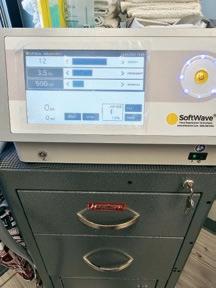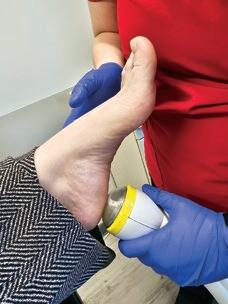
2 minute read
Introducing SoftWave Therapy A

Drug-Free Alternative to Surgery
Advertisement
Written by Julie Underwood Burton
Dr. Benjamin Weaver sees over 500 patients each month at Central Kansas Podiatry Associates, and many are seeking relief from common foot problems such as plantar fasciitis, Achilles tendonitis or posterior tibial tendonitis. He also treats many wounds of the foot and leg, a complication associated with diabetes.
Now Dr. Weaver can successfully address all these ailments using SoftWave Tissue Regeneration Technologies, a safe, non-invasive treatment that sends short and frequent high intensity bursts of mechanical energy, in the form of a shock wave, deep into injured or inflamed soft tissue at the cellular level. “Amazingly, these energy waves turn on the body’s natural healing by basically tricking the body to into thinking it is being traumatized. New blood cells, along with stem cells, are triggered into action to build that tissue back up stronger and faster,” says Dr. Weaver. “One of the most significant things about this treatment is I have not seen many recurrences of the wound after SoftWave treatment has been completed.”
ShockWave technology has been around for a long time. It’s the standard of care for soft tissue injuries in Europe and has been a non-surgical option in the U.S. for 20 years. Contrary to traditional treatments, SoftWave requires no anesthesia or numbing agents, and with the patented SoftWave applicator, a deeper and larger area can be treated, up to seven by 12 centimeters. Another benefit for Dr. Weaver’s patients is actual treatment and recovery times are significantly reduced, and the treatment is often long lasting. Studies show success rates of up to 60 to 90 percent.
“Typically, we can treat any area from the knee down.
In addition to the typical heel and foot ‘itis,’ — also known as soft tissue or musculoskeletal issues — I can also treat neuropathy, and have even treated rheumatoid arthritis. After an initial evaluation patients come to the office, usually once per week, and one SoftWave treatment only requires 15 minutes of a patient’s time. A full cycle of treatments takes between six and eight weeks, and benefits can last up to four months or more,” says Dr. Weaver. SoftWave is FDA approved for treatment of wounds and musculoskeletal problems and can be combined with other treatment modalities such as physical therapy, chiropractic, massage and soft tissue mobilization.

Dr. Weaver introduced SoftWave as a treatment option at Central Kansas Podiatry Associates six months ago. What patients appreciate most is avoiding surgery, shots or steroids. Treatments are painless and there are no side effects such as bruising or swelling. SoftWave treatments are not covered by insurance, but often the initial visit, evaluation, ultrasounds and x-rays are covered. Notably, for wound care such as a diabetic ulceration, venous ulceration or any wound on your foot, treatment is a covered expense for Medicare patients. For uncovered costs, patients often use their health savings or flex spending accounts to pay for SoftWave packages, which start as low as $400 for four treatments.
For more information about this innovative treatment modality, call Central Kansas Podiatry at 316.269.3338.









